Status Overview
Chiloxanthus pilosus (Fallén, 1807) has been designated Nationally Rare and Near Threatened in the 2015 review of aquatic and semi-aquatic bugs (Natural England, 2015).This is the same designation given to the species in 2001 where it was given a Great Britain (GB) threat category of “Near Threatened” and placed on the GB red list under the 2001 criteria (JNCC, 2023). The current distribution may be poorly understood and there are only 22 records on NBN atlas. However it is thought to be a rare species which is found in localised coastal populations in Suffolk, Norfolk, Lincolnshire and Kent on the East coast of England and Lancashire and Cumbria in the West.
Previous North-West records
Ribble Estuary – 1998
Habitat
In the UK the bug is known from only a very small number sites in coastal areas, where it is confined to salt marshes, preferring bare silty areas on the middle and lower zones. These areas are particularly sensitive to rising sea levels and also threatened by reclamation for agriculture and urbanisation (Natural England, 2015: Cook, 2023).

Aerial view of Ribble Estuary, Marek Ślusarczyk.

Hesketh Out Marsh – Ribble Estuary. Natural England / Peter Wakely (CC BY-NC-ND 2.0)
Life History
Current Knowledge is limited on the ecology of this species but it is assumed to behave in a similar way to Saldula pilosella. S. pilosella is able to tolerate submergence in both nymphal and adult stages. Both insects adults are found from May until September, however it is worth noting that those found after mid-July are most likely the new generation. Many Saldids hibernate away from their summer breeding habitat (Stock & Lattin 1976). In the case of C. pilosus this is theorised to be vegetation or leaf litter away from the littoral zones of the marshes.
Recording and Identification
C. pilosus is an easily recognised species due to its pale pronotal margins in addition to long dark hairs along the dorsal surface (British bugs, 2023). The 2nd tarsal segment is approximately the same length as the 3rd and the wing membrane has 5 cells. This differentiates it from the only other related species with pale pronotal margins, Halosalda lateralis, where the 2nd tarsal segment is longer than the 3rd and the wing membrane has 4 cells (Pericart, 1990; Natural England, 2015).
Although the rarity of the insect and its apparent absence at most coasts could be partially a result of under recording, other Salidid bugs in saltmarshes have been recorded much more frequently and in wider ranges. It is unlikely C. pilosus would have been missed in these searches due to its characteristic appearance (Natural England, 2015).
Conservation
Although the insect itself does not have any legal protection. several occupied or potentially occupied sites have legal protection. In the North-West, one of the few records has been in the Ribble Estuary where there is active conservation management to protect the habitat. The site is a designated National Nature Reserve.
References
British Bugs (2023), Chiloxanthus pilosus species account. Accessed from: http://www.britishbugs.org.uk/heteroptera/Saldidae/Chiloxanthus_pilosus.html
Cook, M. (2023). Chiloxanthus pilosus species account. Accessed from: https://aquaticbugs.com/chiloxanthus-pilosus/
JNCC (2023). Conservation Designations for UK Taxa 2023. Accessed from: https://hub.jncc.gov.uk/assets/478f7160-967b-4366-acdf-8941fd33850b
Natural England (2015)., A review of the Hemiptera of Great Britain: The Aquatic and Semi-aquatic Bugs (NECR188).
Péricart, J. (1990) Hémiptères Saldidae et Leptopodidae d’Europe occidentale et du Maghreb. Fauna de France Volume 77. Fédération Française des Sociétés de Sciences Naturelles, Paris. 238 p.
Stock, M.W. and Lattin, J.D., 1976. Biology of intertidal Saldula palustris (Douglas) on the Oregon coast (Heteroptera: Saldidae). Journal of the Kansas Entomological Society, pp.313-326.







